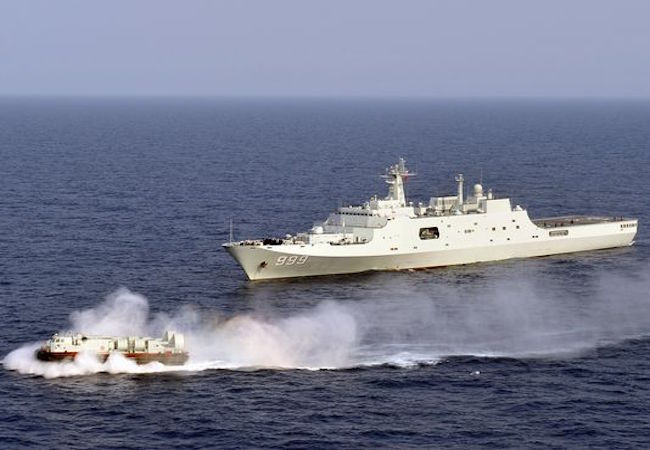Hegemony in Asia: the key islands between China and Japan

The islands and the entangled relationships between China and Japan
China and Japan, the history of the fierce competition between these two great powers can trace back to the demise of the Qing Dynasty. Ever since the first Sino-Japanese War, the “rapport” of these two nations has always been ill. Diaoyu or in Japanese, Senkaku Islands, are in the southeast of China’s Fujian’s province and southwest to Japan’s Okinawa prefecture. The history of these Islands goes back the 15thcentury when the islands were first appeared on the imperial map of the Ming Dynasty, which was marked as a navigational indicator to the Ryuku Kingdom. The Japanese then found the islands in the 18thcentury, identified the islands with both Chinese and English terms. The Islands were annexed by Imperial Japan after they defeated the Qing in the First Sino-Japanese War.[1] After the loss of Japan in WWII, under the Cairo Declaration, all the Islands that Japan has stolen from China should return to China.[2] Yet in 1971, following the pass of the Okinawa treaty by the US senate, the United States acknowledges that the Senkaku Islands should return to Japan in 1972.[3]
In the same year, both People’s Republic of China and the Republic of China (Taiwan) all declared their sovereignties over the Diaoyu Islands, which marks the official dispute of the Islands and paved the way for future conflicts. While we are studying how the islands has damaged the relation between China and Japan, let’s not forget that these islands are less than 3 square miles in combined with no people inhabited at all. Ever since the initial dispute started, these tiny islands are not only hindering the relation between China and Japan but also deteriorating the understanding and communication between the people of these two nations. The question is obvious, is it worthy that both countries would rather mangle their relations than compromising the sovereignty of the tiny islands? Would the occupation of the islands help China or Japan achieve its regional hegemony? It is important to look at what benefits could be brought to the nation which eventually gained the complete control over the territory.
Geopolitical and Strategic Significance
To balance the rise of China, the first “island chain” formed by Taiwan and Okinawa are to contain the Chinese naval power, with the United States military bases in the Okinawa islands. The Diaoyu Islands are at the front of the first island chain, which serve itself as a very crucial position if China wants to break out of the block. In this case, with the respect to national and ethnic pride, Taiwan is on China’s side. We know that the area of the islands is very small and there is no population, but what could a country build there if one does gain the complete control? Let’s look at what is China doing in the South China Sea. After China drew its “nine dashed lines” in the South China Sea, China has been actively starting islands dispute with the southeast Asian countries, occupying the uninhabited islands and reclaiming land from the sea. With a tiny island on the sea, China was able to create their so-called “tourist site” with radar and airport on there.[4] For every islands China has reclaimed, the Chinese government invokes and garbles the statements from the Law of the Sea, claiming new “internal waters” and “archipelagic waters”, which gives China rights to go further into the international waters and reclaim more land.[5]
Imagine if China gains the administration of the Diaoyu Islands, the first island chain would be easily break through, and China, very possibly, will reclaim the lands and connects the islands to form a potential military base, which would be the least thing Japan wants to see. On the other hand, Japan does not get to create anything there due to their Collective Self-Defense Law, but not letting China controls the territory is unarguably a correct strategy. Another worry of the Chinese military is its growing of size and capability, as Mearsheimer concludes that no neighbors of China consider the Chinese navy to be defensively oriented, hence all who are looking to determine the Chinese future intentions by studying its military tend to believe that the Chinese is bent on aggression[6]; prevent China from gaining control over any islands in the East China Sea would be Japan’s priority to defense. Conversely, just like the United States does not want a strong a strong Canada, China does not want a strong Japan, not to mention the Japan with the US military bases, the Chinese surely does not want any US forces near their territory[7], thus having control over the Diaoyu Islands would be a great solution for them to counterbalance Japan and the US military bases in Okinawa, while making progress to break the first island chain.
Resources and Economical Importance
With geopolitical and strategic value as the main benefit of having control of Diaoyu Islands, the resources around the islands come as the secondary interests for both nations. Again, with the United Nations Convention on the Law of the Sea, having the Diaoyu Islands as a territory land or water gives the country an extra Exclusive Economic Zones, which provides the exclusive rights of exploitation of all natural resources to the country, including fishing rights and building oil extraction platforms.[8] Perhaps the resources around the islands would not greatly contribute to either country’s economic growth, but both countries regard the resources as a great benefits to opponent. Similar to how Mearsheimer indicates that how the Australians would view China if China continues its fast economic growth for twenty more years, Japan does not want to see that especially when China uses its wealth to create the military with advanced equipment.[9] No one knows what kind of resources are laying under that territory and its 200 nautical miles, and best thing China and Japan could do is to dispute it while not letting each other goes near the territory.
The Role of the United States
On the surface, the United States is not making any strong actions when the Chinese send their “Law-Enforcement” ships to patrol around the islands. However, the United States are no doubt the meddler between China and Japan, hoping Japan would have control over the islands. Not to mention the U.S military bases in South Japan and its Sino-American Mutual Defense Treaty with Taiwan, the strategy to contain China is more than obvious. However, the “semi-offshore balancing” strategy in East Asia remains questionable. I call it semi-offshore balancing because the US still has a large number of military personnel in East Asia but its also trying to balance China with favored regional powers. However, I agree with Walt and Mearsheimer on the US strategy in East Asia, China is becoming much more powerful than its neighbors, and the US favored states are located far from others which makes it more difficult for those nations to form a coalition.[10]
In this case, Taiwan would rather mainland China to have the Diaoyu Islands than Japan controls over them, and South Korea are in dispute with Japan over the sovereignty of the Jukdo Islands and comfort women issues from WWII, all of these makes the US impossible to form a steady coalition to against China in the Islands dispute. Therefore, the US must come forward and seize every opportunity to contain China. The Obama administration has expressed its commitments of Article Five of the Mutual Cooperation and Security Treaty between Japan and the US, declaring that all the Japanese territory including the Diaoyu Islands are covered and applies to the treaty. Nevertheless, both China and Japan still send their ships to the area, causing troubles and damaging their relations. The conflict can easily turn to an armed conflict if China and Japan are not heavily tied with each other economically, but no one should overlook the dispute and the potential threats, after all, “states can never be certain about each other’s intentions”.[11]
Conclusion
The Diaoyu Islands is part of the game among the major powers. To China, it could be its first step to break the island chain, and to Japan, complete control over the islands is one of the most crucial strategies for it to remain as an influential hegemonic power. To the United States, the islands is one of the key pawns to balance the power in the Asia-Pacific region. No matter for strategic value or simply for the resources, the acquisition of such tiny islands could actually help either country to achieve its regional hegemony. However, no nation should tamper or deliberately damage another nation and its people’s image in order to evoke the national and ethnic hatred toward one another.
References
[1]Suganuma, 51
[2]Cairo Declaration
[3]1971 Okinawa Reversion Agreement, Article 1.
[4]Derek Watkins, What China Has Been Building in the South China Sea.
[5]United Nations Convention on the Law of the Sea, Part IV, Article 46-54
[6]Mearsheimer, Gathering Storm, 384
[7]Ibid, 390
[8]United Nations Convention on the Law of the Sea, Part IV, Article 48
[9]Mearsheimer, Gathering Storm, 394
[10]Walt and Mearsheimer, The Case for Offshore Balancing, 81
[11]Dale C. Copeland, The Origins of Major War
Additional sources
- Suganuma Unryu, Sovereign Rights and Territorial Space in Sino-Japanese Relations: Irredentism and the Diaoyu/Senkaku Islands,University of Hawaii Press, 2000 –
- Cario Declaration, Chiang Kai-shek, President Franklin D. Roosevelt, and Prime Minister Winston Churchillmet November 25, 1943.
- 1971 Okinawa Reversion Agreement, 1971
- Derek, Watkins, What China Has Been Building in the South China Sea, New York Times, October 17th, 2015
- United Nations Convention on the Law of the Sea, Part IV, Article 46-54.
- Stephen M. Walt, John J. Mearsheimer, The Case for Offshore Balancing, A Superior U.S. Grand Strategy, Foreign Affairs
- Dale C. Copeland, The Origins of Major War (Ithaca: Cornell University Press, 2000), Chapter 1; Thomas Hobbes, Leviathan, ed. C. B. Macpherson (Harmondsworth: Penguin, 1985).






